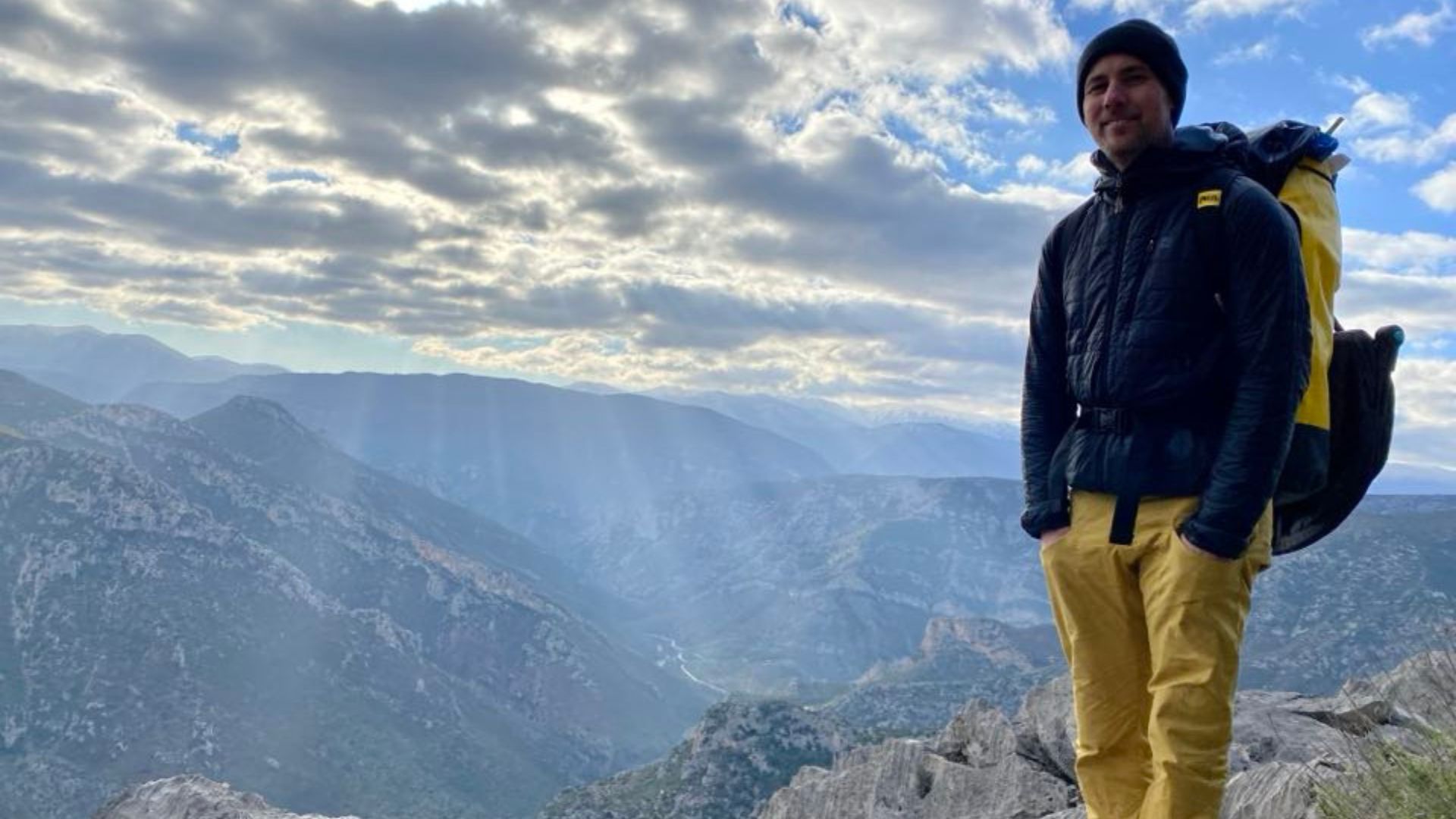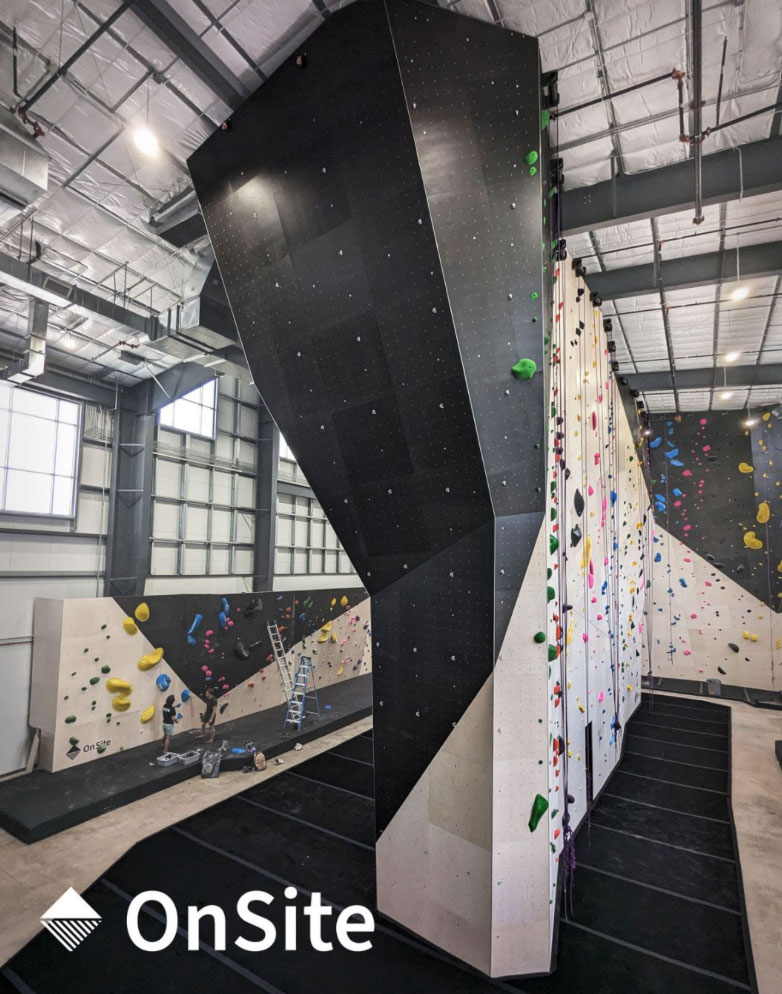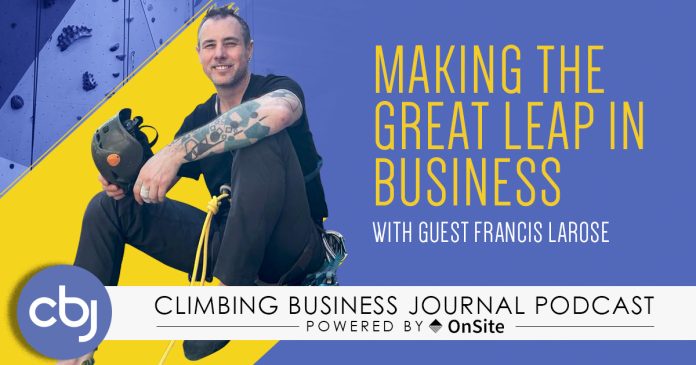
Today’s guest is the founder and CEO of OnSite, Francis Larose. OnSite is based in Montreal, Quebec, and made history this past summer when it became likely the first North America-based wall manufacturer to complete a commercial climbing gym project in Europe. OnSite making the leap from the North American market to the European market is the reverse of what typically happens; much more common has been European builders pursuing gym projects in North America. That accomplishment for OnSite is a focal point of today’s episode, but Francis and host John Burgman cover a lot of other ground too, including Francis’s prior work in the video game industry, OnSite’s urban boulders, and advice for other North American brands looking to go global.
Thank you OnSite for your support!
And thank you Devin Dabney for your music!
Timestamps
00:00 – Intro
03:02 – From Video Games to Climbing Walls
10:25 – The Climbing User Experience
15:01 – Influence of Video Games on Climbing Walls
17:13 – Urban Boulders
21:20 – Criticism of Urban Boulders
23:55 – Private Urban Boulders
26:02 – Climbing on Real Rock
29:57 – The Training Board Boom
35:36 – Routesetters vs. Training Boards?
39:31 – Training-Focused Gyms
46:36 – OnSite’s Jump to Europe
54:53 – Challenges of Working Abroad
01:01:20 – International Business Culture
01:05:00 – Advice for North American Brands Looking to Go Global
01:07:52 – OnSite’s Future in Europe
01:10:32 – Looking Forward
01:15:56 – Closing
Abridged Transcript
BURGMAN: …What did you do in the video game industry? And then how do you get from point A to point B? How do you go from video games to climbing walls and the climbing business?
LAROSE: …The story behind it is I’ve been in gaming almost all my life. So, 18 to 32 [years old]. And at 32, I kind of realized that working behind a computer, like, 100 hours a week was too virtual for me, was too digital for me. It was like there was something missing. In 2010—I started climbing pretty late in my life—one of my great friends [said to] get out of my computer at some point. Like, “Go, let’s go climbing together.” And I kind of felt something [on that trip]. I realized I’m missing something in my life, and I need to change that. I need to reconnect with something real, with something tangible, with something that I can touch. And that was the spark.
At that time I said, “Okay, I need to sell my video game business, I need to do something, I need to change.” Then I started to think I could change my professional career, and I knew that my next business [was] going to be in climbing. I didn’t know what it was going to be, but I knew that if I’m going to open another business after the video game [business], it was going to be in climbing. So, that was kind of the beginning. I was passionate about video games and I felt passionate about climbing, and when I’m passionate about something I usually try to make my own money out of it…

…What was it about climbing that really intrigued you about the user experience there, and made you feel like, “Hey, I could really offer something here, I could help contribute to this”?
…I’ve always been in entertainment businesses. This is the continuity [throughout] my career path. Video games, board gaming, sport, that kind of thing. Food, where you eat the food, you’re like, “Wow, that was amazing.” So, I always pursued that kind of user experience. And when we started OnSite—just a bit of background—the first concept, the first vision of OnSite, was not building walls for interior gyms, [but] was delivering urban boulders in city parks. And urban boulders, when we did their first prototype, when we did their first business model, the experience that we wanted to make is that you don’t have to drive an hour to go boulder outside the city. You take the subway, you take your car, you walk directly to a park nearby your home or your apartment, and you go have this feeling of touching real rock, [within] walking distance from your home, with your crash pad. That was the…wild moment that we wanted, to get this experience of getting real rock in a city. And that was the first vision…
When we designed the first wall for OnSite, the experience that we wanted to achieve is that clients don’t climb in a garage, they don’t climb in a woody…they climb on the wall designed by an industrial designer with an architectural background. And the idea was to create lines that speak unconsciously to people. These lines that when you look at the house and you say, “Wow, that house is unbelievable, it’s good looking,” but you don’t actually know why it is because you don’t have the design background. But you feel it; you feel that this house is better than the other, for some reason that designers and the architect knew but the climbers didn’t know. So, we wanted to create that line. We want to create that color pattern. The climbers don’t know why, but [they’re] attracted to it compared to another gym…
Was some of this [work] influenced by your video game work?…
…Part of my video game experience is you create something that most of the players don’t know what’s going on, but they’re having an experience, they’re feeling something, they’re playing to reach something, but they don’t know exactly what the mechanics behind it are that create that feeling. And at this point right now, all the game designers and all the experts, they’re so good right now. That became Fortnite kind of stuff, where they’re playing and then you “trick” their mind to push the button and buy stuff with the credit card. And I think that went too far…
But we made the video game and the mechanics and the replayability, the fun factor. We made it happen in a way that is like any other science, and [people] would say that video gaming is a science. But what I’m saying is there’s something behind it that people know about, and they push the button to make things happen. So, that’s true. My design background or my video game background, when we look at the gaming industry, I wanted to achieve something. I wanted people to feel something behind the scene without being able to tell what exactly is happening in the front end.
There are a lot of things that OnSite does, as you pointed out—the urban boulders being just one of them. Another thing that I want to make sure we get to—I want to ask you about your training walls, your training boards…Somehow, some way, this year training walls are huge in gyms and they’re becoming hugely popular. Is that something that you have detected as well, being a manufacturer of training walls?
Yeah, [for the past] two years there is absolutely no new climbing gym that won’t have training walls. And a year ago, it’s like 100% of new gyms will have a training wall. Right now, it’s like the gyms will have two training walls.
We have a project that is like a 24 wide by 15 adjustable, which could be used as two training walls or one big spray wall. It’s becoming very, very mandatory in a climbing gym to get that. We kind of [foresaw] that three to four years ago, while in the pandemic. I think it’s a combination of two things: [Since] the pandemic, the building sizes are kind of reducing because all the good buildings have been taken by other climbing [gyms]. So, there’s configuration about the building that needs to kind of reinvent what is the climbing.
Then after that I think it really started good with Moon, the MoonBoard, which was not necessarily the first one but was in the first wave…where if you want to train hard, if you want to be the best climbers in the world, you go train on the MoonBoard. And then TB1 has the same kind of feeling as well. And everything changed with the newcomers, with Kilter’s and TB2, where they make it beautiful, where they make it likely, where they kind of achieved the vision of the beginning of the project. And that’s where I think the spark started…
…How did OnSite make the leap across the ocean into Europe?
It’s a long story that has a lot of implications and a lot of other smaller stories behind it. But it’s true that what we are accustomed to is [sic] coming into the U.S. market. So, we have a lot of competitors, huge wall builders, international wall builders, that either created sub-brands in the U.S. or either just use their name in Europe and create branches, business branches, in the U.S. I’ve been delivering walls over and over the last 20 years, and I don’t remember [it happening in reverse]. Maybe someone did it, but in the modern climbing gym, over the last couple of years, I don’t remember seeing a wall builder ship walls, ship a project from the U.S. to Europe. So, why did that happen to us?
There is a combination of my home personal network, but there’s also something that is special for the Quebec province in Canada, the French speaker in North America. There’s something very, very fit to that. So, we’re French. It’s easy for us to negotiate a deal with French people in France. And it’s also easy to create some kind of bridge between the North American market and European market. We are a little bit European in their mind for a lot of different reasons—my grandfather was French, [etc.]. So, we have a bunch of European people coming in because they often think—I don’t know if it’s true, but they often think that is the first step, to arrive in Quebec. They’re kind of a smaller fit in culture. There’s like a better cultural fit, if I could say it that way. And since the beginning, I’ve always been making international business, and Europe was always one of my markets. When I was in the video game [industry], the U.S. was a good market, but the European market, my client was there as well. So, I always had some ease in dealing with them. And so that was the start: It was easy for me to look at that market. And after that, we wanted to expand….
Two years ago, we were happy with what we were doing in the U.S. market, and we thought about what is the next step for us if we want to continue to grow, if we want to continue to bring our brand, if we want to continue to bring our project, what is the next step? And the next step was the obvious European market. Not because it was a good market, but because we had the network, because we knew how to deal with them, because we had a lot of friends over there, because I have a lot of connections over there. So, that was a natural opportunity…

…What were some of the challenges of being a North America-based company and having to do business with a European gym?…
…The most difficult challenge that anybody in the U.S. will have, we didn’t. So, the challenge we had was on a different scale, in different ways. Because sending people, dealing with the visas and so on, that was all taken care of with French people that we hired in French, and we knew how to deal with them. So, we have the right person to cover all the legal, administrative, financial, taxes, that kind of thing. And this is one thing where the stars were aligned, and we knew we wouldn’t have any legal or human resources problem. That was part of the risk that we mitigated from the start, from the beginning.
What I will say was the biggest challenge for us from the beginning was the cost of our project. So, there’s a huge, huge difference in price in Europe compared to the U.S. market. I’m not ready to drop numbers yet because I’m going to have some other communication moving forward by the end of the year. But that was the main challenge for us. And we had to work with East European manufacturers for some steel. We had to work a lot to reduce our costs. And that will bring goods to the U.S. market moving forward. We have something for the U.S. market coming out about the cost for climbing. That was the huge thing…
…What are you most excited about in the future with OnSite?…
When we started OnSite, we were in a shifting transition in the industry of climbing, like eight years ago. And I do think right now we are in special times in the climbing industry, where things are shifting…I’m excited where the climbing is leading, and we have an answer for that, and I’m more excited about the ideas of what we’re going to bring later on.
For the project itself, I think the modern climbing wall has changed. So, what was our answer eight years ago is not going to be the same answer tomorrow, in terms of the user experience, and I’m kind of ready to scratch a little bit. We are changing our design principles as we speak. Our design principles at OnSite used to be aesthetic, it used to be architectural, it used to be look and feel. Right now, we’re changing our principles and we’re thinking in terms of canvas, we’re thinking in terms of frame. But I like canvas—OnSite will evolve into a canvas provider. And what does this mean? It’s the best painting tool, the best brush, the best color, the best tools for the gym owner to evolve in the industry. And I think modern climbing, this is where it’s going…

John Burgman is the author of High Drama, a book that chronicles the history of American competition climbing. He is a Fulbright journalism grant recipient and a former magazine editor. He holds a master’s degree from New York University and bachelor’s degree from Miami University. In addition to writing, he coaches a youth bouldering team. Follow him on Twitter @John_Burgman and Instagram @jbclimbs. Read our interview Meet John Burgman, U.S. Comp Climbing’s Top Journalist.








